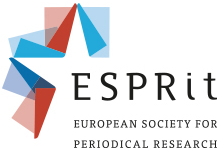ESPRit online seminar with Yelizaveta Raykhlina and Effrosyni Zacharatou
ESPRit online seminars, Autumn 2021: ‘Crossover influences and local identities of the popular illustrated periodicals of the nineteenth and twentieth centuries’
Autumn series 2021, Session 3 - December 10, 3PM CET:
1) Yelizaveta Raykhlina (New York University), From Paris to the Russian Provinces: Russian-language Fashion Magazines of the late 1830s and 1840s as Domains of Cultural Adaptation and Women’s Entrepreneurship”.
This presentation explores the role of the Russian-language illustrated fashion press as a forum for translating and adapting French fashion for Russian readers during the late 1830s and through the 1840s. These years serve as a turning point in the development of the Russian press, as they mark the emergence of the first Russian fashion magazines that were founded by women entrepreneurs. Coming from non-noble origins, these women publisher-editors (Elizaveta Safonova and Mariia Koshelevskaia) had the unusual role of reporting on French fashion to Moscow and Petersburg high society and, importantly, on French and Russian fashion to provincial Russian noblewomen. The purpose of their magazines was not to imitate foreign styles, but to adapt them to Russian needs; in the process, these fashion magazines joined a broader conversation taking place across the Russian periodical press about defining “Russian” culture. The long print run of these magazines is a testament to their editors’ successful strategies, made all the more impressive at a time when new Russian periodicals folded within a year of their launch. While the Russian-language press was always in conversation with the European presses of the time (particularly French, German, and English), current scholarship tends to treat Russian periodicals separately. This presentation aims to stimulate a conversation about integrating Russian press history into a broader European context."
2) Effrosyni Zacharatou (Athens School of Fine Arts), From Europe to Greece: The illustrated magazine as a distinct form
The proposed paper, based on my doctoral research, considers the ways in which Greek illustrated magazines emerged in relation to their relationship to the broader, and older, currents of European periodical publishing. The adoption of such a comparative approach is necessary given the absence of any monograph, or indeed any systematic research, on the Greek illustrated magazine, despite the fact that it was a major cultural phenomenon, and an integral part of the visual culture of Greece. The paper begins with an analysis of the circumstances and conditions that led to the emergence of the illustrated magazine in Greece at the beginning of the 19th century. Then it briefly considers a number of key issues, including the following:
- the development in Greece of printing technology, especially lithography and engraving,
- the impact of industrialisation and transport,
- the growth of markets and early capitalist social relations,
- changes in education, culture and ideology, particularly the influence of Saint- Simonianism, social reform movements, the growth of literacy and the rise of the bourgeoisie, along with notions of egalitarianism, the democratization of art, and the emergence of nationalism.
The remainder of the paper considers the ‘external’ characteristics of readership, form, format and pagination, as well as such ‘internal’ characteristics as content (editorial, advertising, image quantity and quality, organic relation between language and image) drawn from a limited number of examples of Greek illustrated magazines. In conclusion, the paper speculates on the relationship between the growth of such periodicals in Greece and the making, at broadly the same time, of an urban middle-class from which it drew its producers, advertisers and readers.
